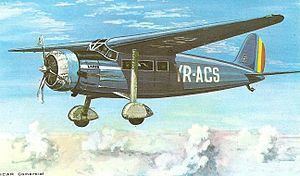Top speed 235 km/h Length 9.8 m | Wingspan 15 m First flight 1934 | |
 | ||
Manufacturer Întreprinderea de Construcții Aeronautice Românești | ||
The ICAR 36 / ICAR Comercial (sic), variously also known as the ICAR M 36, Messerschmitt M 36 or BFW M.36 was a Messerschmitt design built and tested by the Romanian company ICAR in the mid-1930s. It was a small, single-engine high-wing airliner, the first civil transport aircraft built in Romania.
Contents
Design & development
In April 1933, Erhard Milch, previously head of Deutsche Luft Hansa was appointed Secretary of State for Air. Relations between Milch and Willy Messerschmitt had been bad ever since the cancellation and later re-ordering of the BFW M.20 by Luft Hansa, and the future of orders for BFW looked bleak. That summer, a visit was made to Romania where an order was placed by Întreprinderea de Construcții Aeronautice Românești (ICAR) for the design of a small airliner, to be built by them in Romania. ICAR designated it the ICAR 36; Messerschmitt, working at BFW referred to it as the M 36.
Description
The ICAR 36 was a high-wing cantilever monoplane of mixed construction, with closed cockpit, single engine, and a fixed landing gear; a welded steel tube fuselage covered with plywood and tapered single-spar, plywood covered wings. The crew of two sat in the cockpit forward of the wing, which was equipped with a radio and could be fitted with twin controls. The cabin for 6 passengers, with wide rectangular windows and access doors at the rear, was aft and below the cockpit / wings. There were also two baggage compartments.
One aircraft (YR-ACS) was built, later modified with a cabin for five passengers and two luggage compartments. Initially intended to be powered by a licence-built 340 kW (450 hp) Gnome & Rhône 7K radial engine, the aircraft was eventually fitted with a 280 kW (380 hp) Armstrong Siddeley Serval I 10-cyl radial engine in a NACA cowling., which was, in turn, replaced with a 220 kW (300 hp) Lorraine 7M Mizar 47, driving a three-bladed propeller. The fixed landing gear was supported by long faired vertical struts to the wings, with tear-drop spats over the main-wheels and a tail-wheel at the end of the fuselage.
A tri-motor development was planned, but not realized.
Operational history
Only one aircraft was built, operated by LARES on several internal routes including the Bucharest to Cernauti route.
Operators
Specifications (I.C.A.R. 36 Comercial)
Data from
General characteristics
Performance
